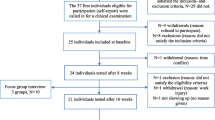Abstract
This prospective controlled study examined changes in fitness, health, and work ability after a work-oriented physical fitness course arranged for lumberjacks experiencing low back pain but being still at work. The 1-week courses were designed to activate exercising during leisure time and consisted of fitness tests, various types of exercise, and lectures. Eighty-seven lumberjacks participated in the courses and 61 subjects served as controls. Questionnaire data obtained before and 1 year after the course were available for 78 (90%) of the course participants and 41 (67%) of the controls. In the intervention group, perceived fitness, health, and work ability improved and ergonomic strain at work decreased. Both groups reported an increased frequency of leisure-time physical activity. There were between- group differences in the development of fitness, health, distress symptoms, and subjective work ability, whereas the changes in physical activity, back and musculoskeletal symptoms, or ergonomic strain did not differ between the groups. In a 6-month follow up, muscle function improved in the intervention group, but no change was observed in aerobic capacity. There was a tendency of the number of back pain-related sickness leaves, but not of their duration, to develop more favorably in the intervention group, when data from the year before and the year after the course were compared.
Similar content being viewed by others
References
Kukkonen-Harjula K, Rauramaa R. Oxygen consumption of lumberjacks in logging with a power-saw.Ergonomics 1984; 27: 59–65.
Hagen KG,et al. Physical workload, perceived exertion, and output of cut wood as related to age in motor-manual cutting.Ergonomics 1993; 36: 479–488.
LEL pensions 1991 (in Finnish). LEL Employment Pension Fund, 1992.
Battié MC, Bigos SJ, Fisher LD, Hansson TH, Nachemson AL, Spengler DM, Wortley MD, Zeh J. A prospective study of the role of cardiovascular risk factors and fitness in industrial back pain complaints.Spine 1989a; 14: 141–147.
Battié MC, Bigos SJ, Fischer LD, Hansson TH, Jones ME, Wortley MD. Isomeric lifting strength as a predictor of industrial back pain reports.Spine 1989b; 14: 851–856.
Cady LD, Bischoff DP, O'Connell ER, Thomas PC, Allan JH. Strength and fitness and subsequent back injuries in fire-fighters.J Occup Med 1979; 21: 269–272.
Leino P, Aro S, Hasan J. Trunk muscle function and low back disorders: A ten-year follow-up study.J Chron Dis 1987; 40: 289–296.
Genaidy AM, Karwowski W, Guo L, Hidalgo J, Garbutt G. Physical training: A tool for increasing work tolerance limits of employees engaged in manual handling tasks.Ergonomics 1992; 35: 1081–1102.
Shephard RJ. A critical analysis of work-site fitness programs and their postulated economic benefits.Med Sci Sports Exercise 1992; 24: 354–370.
Frank A. Low back pain. Regular review.BMJ 1993; 306: 901–909.
Nachemson A. Work for all. For those with low back pain as well.Clin Orthop Rel Res 1983; 179: 77–85.
Wickström G. Evaluation of Work-Related Intervention Studies to Prevent Chronification of Back Disorders. Publication series of the research group Health Risks and Preventive Policy, Wissenschaftszentrum Berlin für Sozialforschung, Berlin, 1992.
Lindström I, Öhlund C, Eek C, Wallin L, Peterson L-E, Nachemson A. Mobility, strength, and fitness after a graded activity program for patients with subacute low back pain. A randomized prospective clinical study with a behavioral therapy approach.Spine 1992; 17: 641–649.
Leino P. Does leisure time physical activity prevent low back disorders? A prospective study of metal industry employees.Spine 1993; 18: 863–871.
King PM. Back injury prevention programs: A critical review of the literature.J Occup Rehab 1993; 3: 145–158.
Leino P, Hänninen K, Kivekäs J. Working conditions, health, and the need for early rehabilitation among LEL insured employees (in Finnish with English summary). Publications of the LEL Employment Pension Fund 1991; 18.
Kivekäs J, Hänninen K. Early rehabilitation courses for lumberjacks (in Finnish). Publications of the LEL Employment Pension Fund 1992; 19.
Lange Andersen K, Shephard JR, Denolin H, Varnauskas E, Masironi R.Fundamentals of exercise testing. Genova: WHO, 1971.
Viljanen T, Viitasalo J, Kujala U. Physical Activities and Aerobic Power of Healthy Adults. 3rd Congress on Sports for All, Tampere, Finland, 1990.
Väyrynen S, Paalasmaa J, Könönen U. Effect of instruction in work technique on work postures during an early rehabilitation course for lumberjacks (in Finnish).Työterveyslaitoksen Tutkimuksia 1985; 3: 324–331.
Kohl HW, Blair SN, Paffenbarger RS, Macera CA, Kronenfeld J. A mail survey of physical activity habits as related to measured physical fitness.Am J Epidemiol 1988; 127: 1228–1239.
Gionet NJ, Godin G. Self-reported exercise behavior of employees: A validity study.J Occup Med 1989; 31: 969–973.
Silverstein BA, Armstrong TJ, Longmate A, Woody D. Can in-plant exercise control musculoskeletal symptoms?J Occup Med 1988; 30: 922–927.
Hughes JR. Psychological effects of habitual aerobic exercise. A critical review.Prev Med 1984; 13: 66–78.
Rose CE, Hayes D. Exercise and psychologic well-being in the community.Am J Epidemiol 1988; 127: 762–771.
Jensen MP, Turner JA, Romano JM, Karoly P. Coping with chronic pain: A critical review of the literature.Pain 1991; 47: 249–283.
Isacsson A, Hanson BS, Janzon L, Kugelberg G. The epidemiology of sick leave in an urban population in Malmö, Sweden.Scand J Soc Med 1993; 20: 234–239.
Leino P, Berg M-A, Puska P. Is back pain increasing? Results from national surveys in Finland during 1978/9–1992.Scand J Rheumatol 1994 (forthcoming).
Leino P, Magni G. Depressive and distress symptoms as predictors of low back pain, neck-shoulder pain, and other musculoskeletal morbidity: A 10-year follow-up of metal industry employees.Pain 1993; 53: 89–94.
Härkäpää K. Psychosocial factors as predictors for early retirement in patients with chronic low back pain.J Psychosom Res 1992; 36: 553–559.
Tuomi K, Toikkanen J, Eskelinen L, Backman AL, Ilmarinen J, Järvinen E, Klockars M. Mortality, disability and changes in occupation among aging muncipal employees.Scand J Work Environ Health 1991; 17(Suppl.l): 58–66.
Author information
Authors and Affiliations
Rights and permissions
About this article
Cite this article
Leino, P., Kivekäs, J. & Hänninen, K. Effects of work-oriented fitness courses in lumberjacks with low back pain. J Occup Rehab 4, 67–76 (1994). https://doi.org/10.1007/BF02110046
Issue Date:
DOI: https://doi.org/10.1007/BF02110046




